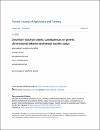Chromium toxicity in plants: consequences on growth, chromosomal behavior and mineral nutrient status
| Author | Saleem, Muhammad Hamzah |
| Author | Afzal, Javaria |
| Author | Rizwan, Muhammad |
| Author | Shah, Zia Ul Hassan |
| Author | Depar, Nizamuddin |
| Author | Usman, Kamal |
| Available date | 2022-08-31T05:52:57Z |
| Publication Date | 2022-01-01 |
| Publication Name | Turkish Journal of Agriculture and Forestry |
| Identifier | http://dx.doi.org/10.55730/1300-011X.3010 |
| Citation | SALEEM, MUHAMMAD HAMZAH; AFZAL, JAVARIA; RIZWAN, MUHAMMAD; SHAH, ZIA-UL-HASSAN; DEPAR, NIZAMUDDIN; and USMAN, KAMAL (2022) "Chromium toxicity in plants: consequences on growth, chromosomal behavior andmineral nutrient status," Turkish Journal of Agriculture and Forestry: Vol. 46: No. 3, Article 10. https://doi.org/10.55730/1300-011X.3010 |
| ISSN | 1300011X |
| Abstract | Chromium (Cr) is a heavy metal of commercial importance; thus, significant amounts are released in wastewaters. The mobility and distribution of metals in the environment is related not only to their concentration but also to their availability in the environment. Most chromium (Cr) exists in oxidation states ranging from 0 to VI in soils but the most stable and common forms are Cr(0), Cr(III), and Cr(VI) species. Cr can have positive and negative effects on health, according to the dose, exposure time, and its oxidation state. Its behavior in soil, its soil-plant transfer and accumulation in different plant parts vary with its chemical form, plant type and soil physicochemical properties. Soil microbial community plays a key role in governing Cr speciation and behavior in soil. A number of factors have been identified to influence Cr toxicity on activated sludge, such as, pH, biomass concentration, presence of organic substances or other heavy metals, acclimation process, exposure time, etc. Inside plants, Cr provokes numerous deleterious effects to several physiological, morphological, and biochemical processes. Cr induces phytotoxicity by interfering plant growth, nutrient uptake and photosynthesis, inducing enhanced generation of reactive oxygen species, causing lipid peroxidation and altering the antioxidant activities. The present review describes the consequences of Cr toxicity on plants, including morphological, physiological and ultrastructural changes. This review also provides the basic concepts of Cr translocation and interaction with other essential macro-and microelements. Moreover, based on the available literature and current research scenario, this review suggests some possible management and remediation strategies to alleviate Cr toxicity and contamination in soil. It also provides valuable knowledge for further studies towards enhancement of soil phytoremediation and crops improvement. Therefore, there is a dire need to monitor biogeochemical behavior of Cr in soil-plant system. |
| Language | en |
| Publisher | the Scientific and Technological Research Council of Turkey (TUBITAK) |
| Subject | Chromium ecotoxicology oxidative stress plant growth and nutrition remediation |
| Type | Article |
| Pagination | 371-389 |
| Issue Number | 3 |
| Volume Number | 46 |
| ESSN | 1303-6173 |
Files in this item
This item appears in the following Collection(s)
-
Research of Agricultural Research Station [71 items ]


